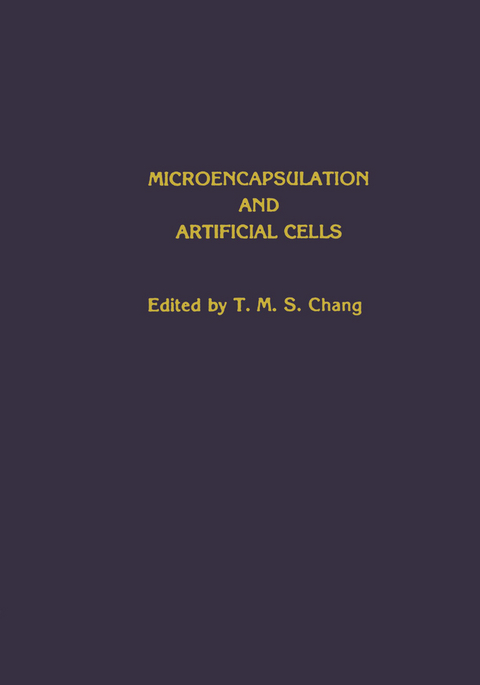
Microencapsulation and Artificial Cells
Humana Press Inc. (Verlag)
978-1-4612-9601-0 (ISBN)
To overcome these platelet and emboli problems, Chang's group (8) proposed the general idea of "artificial cells," Le., microcapsules con- taining adsorbents. Since the charcoal particles were now encased within blood compatible membranes, they could not leave the microcapsules to cause embolism, and platelets did not now come in direct contact with the charcoal. In their early clinical hemoperfusion studies, Chang et al.
Microencapsulation: An Introduction.- Artificial Cells in Medicine and Biotechnology.- Biotechnology: Enzymes, Cells, and Microorganisms.- An Orally Administered Microcapsule System for Treating Chronic Renal Failure Patients.- Enzyme—Albumin Polymers: New Approaches to the Use of Enzymes in Medicine.- Artificial Cell-Microencapsulated Phenylalanine Ammonia-Lyase.- Selection and Microencapsulation of an “NADH-Oxidizing” Bacterium and Its Use for NAD Regeneration.- Radiopolymerized Mixture of Acrylic Acid, Methyl Methacrylate, and Polyethylene Glycol as an Enzyme Support System.- Microencapsulation of Living Cells and Tissues—1983 Review and Update.- Injectable Microencapsulated Islet Cells as a Bioartificial Pancreas.- Microencapsulation of Mammalian Cells in Polyacrylates.- The Preparation of Semipermeable Microcapsules Containing Antibody for Use in Radioimmunoassay.- Design of a Fluidized Bed Reactor for Microencapsulated Urease.- Artificial Red Blood Cell Substitutes.- Artificial Red Cells with Crosslinked Hemoglobin Membranes.- Preparation and In Vitro Characteristics of a Blood Substitute Based on Pyridoxylated Polyhemoglobin.- Preparation and Biophysical Properties of Hemolysate-Loaded Liposomes.- Lipid Microencapsulation of Hemoglobin.- A Blood Substitute from Hydroxyethyl Starch and Hemoglobin.- Adsorbents and Immunosorbents.- Present Status of Hemoperfusion/Hemodialysis in Italy.- Tailor-Made Agarose-Based Reactive Beads for Hemoperfusion and Plasma Perfusion.- Preparation of Polyethyleneglycol (PEG) Coatings for Microencapsulation of Charcoal.- Initial Treatment of Systemic Lupus Erythematosus with a New Artificial Reticuloendothelial System.- Drug Delivery Systems.- Magnetic Microcapsules for Targeted Delivery of Anticancer Drugs.- Microencapsulationof Astiban Acid for the Treatment of Schistosomiasis mansoni.- Drug Targeting by Drug Entrapment into Ultrafine Compartments as Carriers.- Microcapsules for New Animal Drugs.- Microencapsulation of Dichromate and Paracetamol with Eudragit Retard Polymers Using Phase Separation by Non-solvent Addition.- Microencapsulation by a Complex Coacervation Process Using Acid-Precursor Gelatin.- Kinetic Model Identification of Drug Release from Microcapsules Using the Nonlinear Regression Search Procedure.- Preparation and Surface Properties of Encapsulated Powder Pharmaceuticals.- Preparation and In Vivo Studies of a New Drug Delivery System: Nanoparticles of Alkylcyanoacrylate.- A Controlled-Release Anti-Inflammatory Drug: Studies on Microcapsules.- General.- Current Status of Microencapsulated Diets for Aquaculture.- Liquid Crystal Microcapsule Medical Device Used for Thermographic Examination of the Human Female Breast.- Excitable Artificial Cells of Proteinoid.- Inhibition of Human Neutrophil Elastase Activity by Encapsulated Serum (Serumsome ™) Therapy.
| Erscheint lt. Verlag | 8.10.2011 |
|---|---|
| Zusatzinfo | VIII, 320 p. |
| Verlagsort | Totowa, NJ |
| Sprache | englisch |
| Maße | 178 x 254 mm |
| Themenwelt | Sachbuch/Ratgeber ► Natur / Technik ► Garten |
| Medizin / Pharmazie ► Physiotherapie / Ergotherapie ► Orthopädie | |
| Naturwissenschaften ► Biologie ► Biochemie | |
| Technik ► Medizintechnik | |
| ISBN-10 | 1-4612-9601-3 / 1461296013 |
| ISBN-13 | 978-1-4612-9601-0 / 9781461296010 |
| Zustand | Neuware |
| Informationen gemäß Produktsicherheitsverordnung (GPSR) | |
| Haben Sie eine Frage zum Produkt? |
aus dem Bereich


